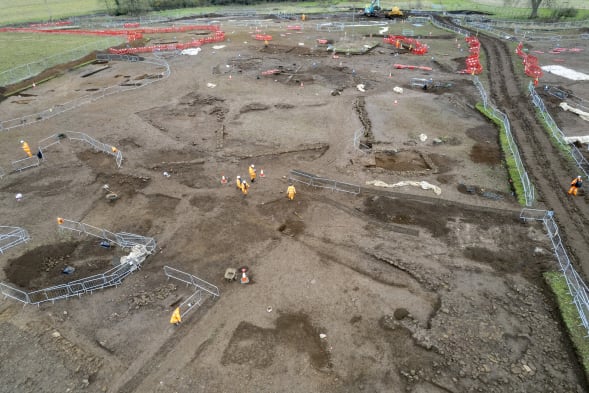Vast Roman town and hundreds of artefacts uncovered during rail excavation
The remains of a vast Roman trading settlement have been discovered by a team of archaeologists working along a future high-speed railway route in England.
Hundreds of Roman coins, jewellery, pottery and a pair of shackles were among the artefacts to be discovered at the site near a village in Northamptonshire, according to a press release from High Speed 2 (HS2) Tuesday.
HS2 is a large-scale project intended to create high-speed rail links between London and major cities in central and northern England.
The site, known as Backgrounds, dates back to around 50 AD, although it initially housed an Iron Age village dating back to around 400 BC, HS2 said.

As an Iron Age road and more than 30 roundhouses were found near the Roman remains, archaeologists believe the Iron Age village developed into a wealthy Roman settlement. The area is believed to have developed over time and become wealthier, with new roads and stone buildings being constructed.

A huge Roman road around 10 meters in width (33 feet) runs through the settlement, far exceeding the normal maximum of around four meters (13 feet), said James West, site manager for MOLA Headland Infrastructure, which oversaw the excavation.
Badger leads archaeologists to a hoard of Roman coins in Spain
Experts believe this road — described as “exceptional in its size” — indicates the settlement was once a busy area with carts going in and out with goods.
“Uncovering such a well-preserved and large Roman road, as well as so many high quality, finds has been extraordinary and tells us so much about the people who lived here,” West said in the press release.

“The site really does have the potential to transform our understanding of the Roman landscape in the region and beyond.”
Giant 180 million-year-old ‘sea dragon’ fossil found in UK reservoir
Unearthed workshops, kilns and several wells suggest the town would have been a “bustling and busy area” at its peak, the press release says. In addition to industrial practices, the foundations of buildings used for domestic purposes were also uncovered.
More than 300 Roman coins were found, suggesting a significant volume of commerce passed through the area. Glass vessels, highly decorative pottery, jewellery and evidence of cosmetics — as the mineral galena, which was crushed and mixed with oil to create makeup — was also discovered.

The quality of the soil, which is a fiery red colour in some parts, suggest activities involving burning took place in the area, such as bread making, metalwork or pottery.

A pair of shackles discovered could also be evidence of either slave labour or criminal activity, the press release says.
The artefacts will be cleaned and examined by specialists, while the layout of the area and details of the buildings are being mapped.
Backgrounds are one of more than 100 archaeological sites between London and Birmingham that HS2 has examined since 2018.
HS2 has unearthed a number of interesting archaeological finds, such as rare Roman statues found at a church in Buckinghamshire and a Roman mosaic at a farm in Rutland in the East Midlands.
